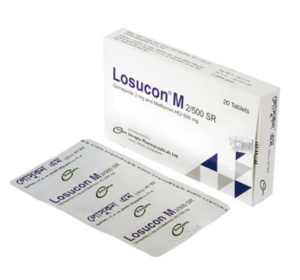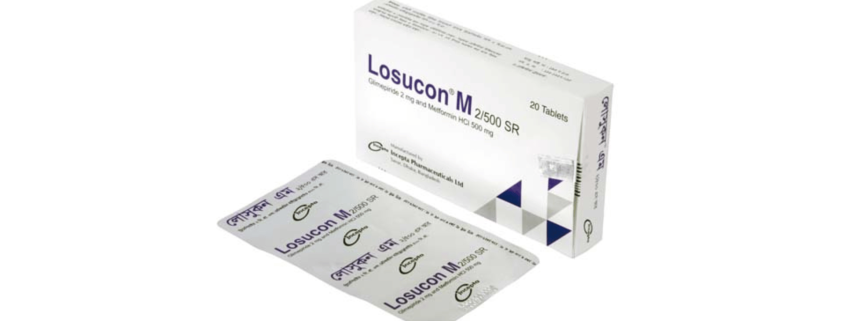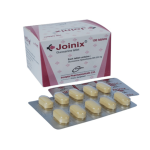Losucon M SR (Glimepiride + Metformin HCL )

Therapeutic Group: Anti Diabetic
Presentation
Losucon M 1/500 SR : Each sustained release tablet contains Glimepiride BP 1 mg and Metformin HCl BP 500 mg
Losucon M 2/500 SR : Each sustained release tablet contains Glimepiride BP 2 mg and Metformin HCl BP 500 mg
Description
Losucon M SR is a combination of 2 oral anti-hyperglycemic drugs with complimentary mechanism of action to improve glycemic control in patients with type-2 diabetes mellitus: Glimepiride, a Sulfonylurea and Metformin, a member of the biguanide class. The primary mechanism of action of Glimepiride, is to stimulate the release of insulin from functioning pancreatic beta cells. Glimepiride acts in concert with glucose by improving the sensitivity of beta cells to physiological glucose stimulus, resulting in insulin secretion. In addition, extrapancreatic effects like reduction of basal hepatic glucose production, increased peripheral tissue sensitivity to insulin and glucose uptake may also play role in the activity of Glimepiride. Metformin decreases hepatic glucose production, decreases intestinal absorption of glucose, and improves insulin sensitivity by increasing peripheral glucose uptake and utilization.
Indications
Glimepiride + Metformin combination tablet is indicated as an adjunct to diet and exercise to improve glycemic control in adults with type 2 diabetes mellitus when treatment with both Glimepiride and Metformin is appropriate or in cases where Glimepiride/Metformin mono-therapy does not result in adequate glycemic control.
Dosage & Administration
The dosage of Losucon M SR must be the lowest which is sufficient to achieve the desired metabolic control. During treatment with Glimepiride + Metformin combination tablet, glucose levels in blood and urine must be measured regularly. The initial recommended dose of Glimepiride + Metformin combination tablet is Glimepiride 1 mg+ Metformin HCl 500 mg one tablet once daily with breakfast or first main meal of the day. Starting dose for patients inadequately controlled on Glimepiride or Metformin monotherapy is Losucon M 1/500 SR once daily, and gradually titrated after assessing the therapeutic response. Titration: The daily dose must be titrated in increments of 1 tablet. The maximum recommended dose per day is 8 mg Glimepiride and 2000 mg Metformin. When switching from combination therapy of glimepiride plus metformin to separate tablets, Glimepiride and Metformin should be administered separately on the basis of dosage currently being taken. Due to the sustained-release formulation, Losucon M SR must be swallowed whole and not crushed or chewed. When Glimepiride + Metformin combination tablet is used in combination or with insulin, a lower dose of the Glimepiride or insulin may be required to reduce the risk of hypoglycemia.
Side Effects
As a result of the blood glucose-lowering action of Glimepiride, hypoglycaemia may occur which may also be prolonged. At the start of treatment, there may be temporary visual impairment due to the change in blood glucose levels. Occasionally, gastrointestinal symptoms e.g. nausea, vomiting, sensations of pressure or fullness in the epigastrium, abdominal pain and diarrhoea may occur. Occasionally, allergic or pseudo-allergic reactions may occur e.g. in the form of itching, urticaria or rashes. Metformin: Gastrointestinal symptoms-nausea, vomiting, diarrhoea, abdominal pain and loss of appetite are very common. Metallic taste is common. A decrease of vitamin B12 absorption with decrease of serum levels has been observed in patients treated long-term with metformin. Lactic acidosis is very rare.
Precautions
Metformin: Lactic acidosis is a rare but serious (high mortality in the absence of prompt treatment), complication of Metformin accumulation which can be fatal. Patients should be cautioned about prolonged fasting and excessive alcohol intake since it potentiates the effects of Metformin on lactate metabolism. It is not recommended in hepatic/renal impairment or hypoxic states. As intravascular administration of iodinated contrast materials in radiologic studies can lead to renal failure, Metformin should be discontinued temporarily. Glimepiride: In the initial weeks of treatment, the risk of hypoglycaemia may be increased and careful monitoring is necessary. In exceptional stress situations (e.g trauma, surgery, febrile infections), blood glucose regulation may deteriorate and a temporary change to insulin may be necessary to maintain good metabolic control.
Use in Pregnancy & Lactation
Pregnancy: The use of Glimepiride + Metformin combination is not recommended for use in pregnancy. Intake may cause risk/harm to child. It is recommended that such patients change over to insulin. Lactation: The use of Glimepiride + Metformin combination is not recommended for use in lactating mothers, and if the diet alone is inadequate for controlling blood glucose, insulin therapy should be considered. Pediatric use: Safety and effectiveness of Glimepiride + Metformin combination in pediatric patients have not been established. Geriatric use: Metformin is substantially excreted by the kidneys, and because aging is associated with reduced renal function, Glimepiride + Metformin combination should be used with caution in the elderly.
Drug Interaction
Based on experience with Glimepiride and known interactions for other sulfonylureas, the following interactions must be considered.In addition to insulin and other oral antidiabetic agents, drugs which may potentiate the hypoglycaemic action of Glimepiride include: ACE inhibitors, aminosalicylic acid, anabolic steroids and male sex hormones, azapropazone, chloramphenicol, clofibrate, coumarin derivatives, cyclophosphamide, disopyramide, fenfluramine, fenyramidol, fibrates, fluconazole, fluoxetine, guanethidine, ifosfamide, MAO-inhibitors, miconazole, oxpentifylline (high dose parenteral), oxyphenbutazone, para-aminosalicylic acid, phenylbutazone, probenecid, quinolones, salicylates, sulphinpyrazone, sulfonamide antibiotics, tetracyclines, tritoqualine, trofosfamide. Drugs which may attenuate the hypoglycaemic action of Glimepiride include: acetazolamide, barbiturates, calcium channel blockers, corticosteroids, diazoxide, diuretics, glucagon, isoniazid, laxatives, nicotinic acid (high doses), oestrogens, phenothiazines, phenytoin, progestogens, rifampicin, sympathomimetic agents, thyroid hormones. H2 receptor antagonists, beta-blockers, clonidine and reserpine may lead to either potentiation or weakening of the blood-glucose-lowering effect. Concomitant treatment with a beta-receptor blocker, clonidine, guanethidine or reserpine may mask the warning symptoms of a hypoglycaemic attack. Acute and chronic alcohol intake may either potentiate or attenuate the activity of Glimepiride in an unpredictable fashion.
Metformin: Increased risk of lactic acidosis in acute alcohol intoxication, particularly in case of fasting or malnutrition and hepatic insufficiency. Avoid consumption of alcohol and alcohol-containing medications. Intravascular administration of iodinated contrast agents may lead to renal failure, resulting in metformin accumulation and a risk of lactic acidosis.
Over Dose
Overdosage of sulfonylureas, including Glimepiride, can produce hypoglycaemia. Mild hypoglycaemic symptoms without loss of consciousness or neurologic findings should be treated aggressively with oral glucose and adjustments in drug dosage or meal patterns. Close monitoring should continue until the physician is assured that the patient is out of danger. Severe hypoglycaemic reactions with coma, seizure, or other neurological impairment occur infrequently, but constitute medical emergencies requiring immediate hospitalization. If hypoglycaemic coma is diagnosed or suspected, the patient should be given a rapid intravenous injection of concentrated (50%) glucose solution. This should be followed by a continuous infusion of a more dilute (10%) glucose solution at a rate that will maintain the blood glucose at a level above 100 mg/dl. Patients should be closely monitored for a minimum of 24 to 48 hours, because hypoglycaemia may recur after apparent clinical recovery. Overdose of Metformin may lead to lactic acidosis. Remove Metformin by haemodialysis.
Storage
Do not store above 30°C. Keep away from light and out of the reach of children.
Commercial Pack
Losucon M 1/500 SR: Each box contains 3 blister strips of 10 tablets.
Losucon M 2/500 SR: Each box contains 2 blister strips of 10 tablets



